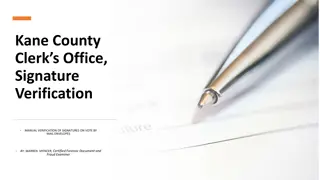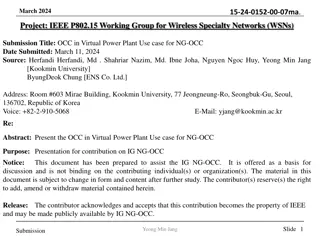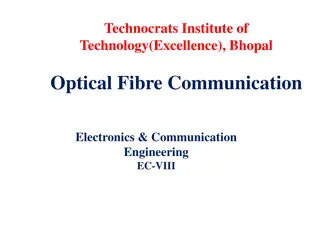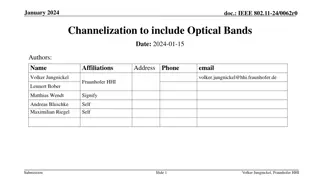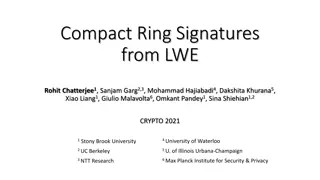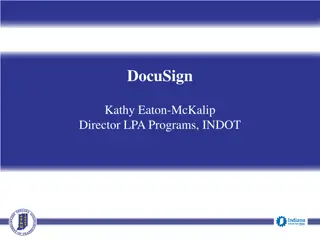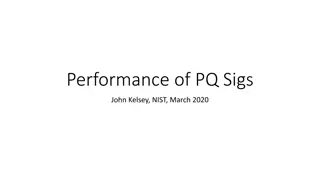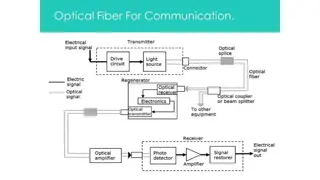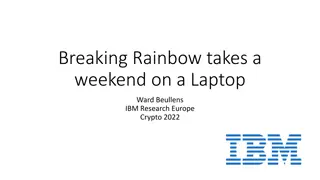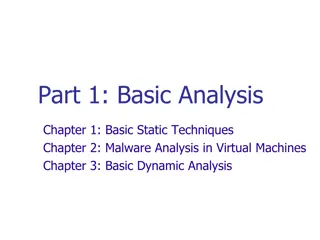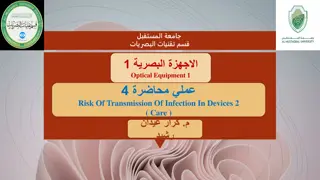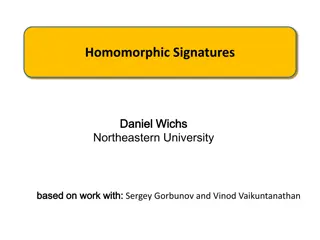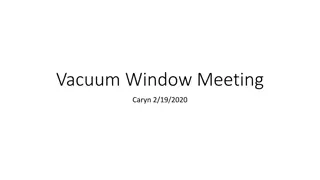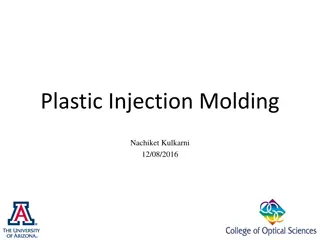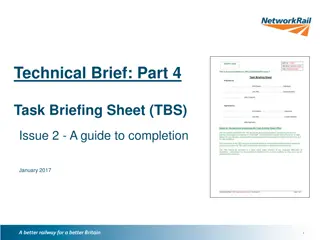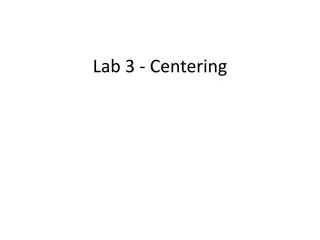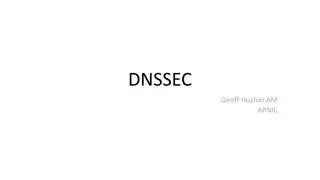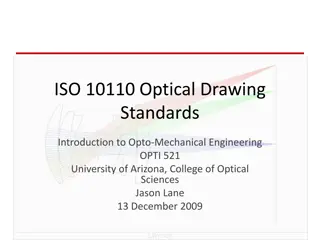Ensuring Integrity: Signature Verification in Mail-In Voting
Kane County Clerk's Office employs certified forensic document examiners for manual verification of signatures on mail-in ballot envelopes, emphasizing the challenges and importance of ensuring authenticity in the voting process. Learn about the technology and processes involved in signature authent
3 views • 28 slides
Next-Generation Optical Camera Communication in Virtual Power Plants
The submission discusses the application of Next-Generation Optical Camera Communication (NG-OCC) in virtual power plants, highlighting its advantages in transmitting data efficiently and reliably in the energy sector. NG-OCC utilizes light for communication, minimizing interference risks and offeri
5 views • 8 slides
Understanding Optical Fiber Signal Degradation in Communication Engineering
Technocrats Institute of Technology (Excellence) in Bhopal delves into the concepts of signal degradation in optical fiber communication, focusing on attenuation, distortion mechanisms, and measurement techniques. The institute emphasizes the importance of signal attenuation and its impact on inform
4 views • 56 slides
Channelization to Include Optical Bands in IEEE 802.11 Standards
This document discusses the proposal to incorporate optical bands into the channelization framework of the IEEE 802.11 standard. It aims to align the channelization approach for integrated LC with that of mm-wave technology in the IMMW scope. The contribution highlights recent works, emphasizing the
2 views • 11 slides
Compact Ring Signatures from LWE - CRYPTO 2021 Research
Research presented at CRYPTO 2021 introduces a compact ring signature scheme using components instantiated from LWE. The scheme allows each signer to sign on behalf of a ring of users, offering properties of unforgeability, anonymity, and compactness. The work explores the possibility of building co
0 views • 25 slides
Optical Properties of Optically Active Compounds
Circular dichroism and optical rotatory dispersion are important techniques for studying the optical properties of optically active compounds. Circular dichroism measures the differential absorption of left and right circularly polarized light components, while optical rotatory dispersion studies th
0 views • 17 slides
Understanding Optical Telescope Types and Lens-Maker's Formula
Optical telescopes utilize lenses or mirrors to collect and focus light for imaging celestial objects. The lens-maker's formula is crucial for determining the focal length of lenses, considering factors like index of refraction and radii of curvature. Different lens configurations and materials help
0 views • 17 slides
Overview of Optical Fibre Technology and Applications
Optical fibre technology, spearheaded by Dr. Prabodh Sahai Saxena, revolutionizes communication systems through light transmission. This cutting-edge technology utilizes fibre optics made of glass or plastic to carry light signals, offering advantages like high bandwidth, low signal loss, and no ele
0 views • 20 slides
Evolution of Optical Technology: From Telegraph to Photonic Integrated Circuits
The journey of optical technology evolution spans from the invention of the telegraph in 1836, through the introduction of optical fibers in 1978, to the development of photonic integrated circuits in the present era. Key milestones include the advent of optical amplifiers in 1990, the emergence of
0 views • 70 slides
Understanding DocuSign Legal Binding Authority for INDOT LPA Programs
This document explains the process of using DocuSign for electronically signing INDOT LPA Contracts and Local Roads and Bridges Matching Grant Agreements. It covers the definition of Legal Binding Authority, requirements for legal signatures per contract, instructions for providing signer informatio
0 views • 18 slides
Performance of Post-Quantum Signatures: Analysis and Comparison
Explore the performance and characteristics of various post-quantum signature schemes including Lattice-based Dilithium, QTesla, Falcon, Symmetric Sphincs+, Picnic, Multivariate GEMSS, Rainbow, and more. Understand the implications of using these schemes in TLS, code signing, firmware updates, signe
0 views • 29 slides
Fiber Optic Communication System Overview
This article presents a detailed explanation of a point-to-point fiber optic communication system, outlining the process from voice conversion to signal transmission and reception. It discusses the advantages and limitations of optical communication systems, along with numerical examples related to
5 views • 11 slides
Optical Equipment Safety Review and Hazard Analysis
This document provides an in-depth review of the safety considerations for the ATST optical equipment, focusing on potential hazards associated with the M2 Mirror, Heat Stop Assembly, and other critical components. The Preliminary Hazard Analysis identifies various risks, causes, and recommended act
0 views • 13 slides
Overview of Laser Delivery Systems for Surgical Procedures
Institute of Laser for Postgraduate Studies at the University of Baghdad, led by Assist. Prof. Dr. Lutfi Ghulam Awazli, focuses on laser delivery systems in surgical procedures. The systems discussed include optical fibers, articulated arms, hollow waveguides, and free beams. Optical fibers, compose
0 views • 10 slides
Understanding Optical Storage Technology
Optical storage technology originally designed for audio offers a capacity of 650MB, providing over 70 minutes of audio playback. Data is recorded digitally on a polycarbonate disk's surface as microscopic pits. The disk is organized in a spiral track with sectors of the same length arranged in bloc
5 views • 16 slides
Advances in Optical Bench Technology for Gravitational Wave Detectors
This content discusses the latest advancements in optical bench technology for gravitational wave detectors, focusing on precise measurements of back-scattered light, development of new optical cavities, and testing of Sagnac interferometers. Key objectives include improving suspension controls, red
0 views • 13 slides
Optical Alignment Using Beam Triangle Opti 521 Phil Scott
This presentation delves into the intricate process of optical alignment using a beam triangle, focusing on defining optical and mechanical axes, addressing alignment challenges, degrees of freedom for various elements, and the importance of setting up a beam triangle for accurate alignment. The con
0 views • 14 slides
Transimpedance Amplifiers in CMOS Technology for Optical Communications at 40 Gb/s
This research by Joseph Chong at Virginia Tech delves into the use of transimpedance amplifiers (TIAs) in CMOS technology for optical communications operating at a data rate of 40 Gb/s. The study outlines the motivation behind the project, the role of TIAs in optical receivers, TIA circuit topologie
0 views • 52 slides
Rainbow Signatures Overview and New Attacks
Rainbow signatures, introduced in 2005, offer good performance with small signatures but raise concerns due to large key sizes. This article explores the history of Rainbow, its vulnerabilities, new attacks, and the challenges posed by multivariate trapdoors. The overview delves into practical impli
0 views • 20 slides
Machine Learning for Molten Salt Reactor Safeguards
Molten salt reactors face challenges in material accounting due to liquid fuel which precludes traditional safeguards. This project proposes a two-step approach involving the development of measurement signatures created by material diversion, and a machine learning model to distinguish normal react
1 views • 18 slides
Comprehensive Malware Analysis Techniques
This detailed guide covers basic static techniques, malware analysis in virtual machines, and basic dynamic analysis. It includes information on static analysis, such as examining payloads without execution, file signatures, and signatures generated via analysis. Additionally, it delves into counter
0 views • 17 slides
Proper Care and Maintenance of Optical Equipment to Prevent Infections
Regular examination and proper cleaning of tonometer prisms are essential to reduce the risk of transmitting infections during eye examinations. Disinfection and sterilization processes are crucial in maintaining optical equipment hygiene. Different disinfectants and physical methods can be used to
0 views • 24 slides
Optical Frequency Interferometer Bench Analysis
Detailed examination of the optical setup for an Optical Frequency Interferometer (OFI) system, including the input/output configurations with various optical components such as prisms, crystals, and wave plates. The analysis focuses on the path and behavior of beams within the system, considering r
0 views • 14 slides
Understanding Homomorphic Signatures and Fully Homomorphic Encryption
Explore the concepts of homomorphic signatures, fully homomorphic encryption, and their unified construction as they relate to security and authenticity in data processing. Learn about commitments, extractable commitments, and equivocal commitments in the context of encryption and signatures.
0 views • 26 slides
Evolution of Optical Fiber Technology
Optical fiber technology has a rich history starting from John Tyndall's demonstrations in 1870 to the development of flexible fiberscopes by Hopkins and Kapany. This technology revolutionized communication systems and medical diagnostics, enabling the transmission of information through thin glass
0 views • 85 slides
Digital Signatures in Legislation: Estonia's Electronic Process
Estonia's legislative process embraces digital signatures, starting with coordination by various institutions and concluding with the enactment of laws electronically. The process involves e-consultation, government systems, digital signing of draft legislation, and ID-card authentication. The final
0 views • 10 slides
Distinctive Signatures of Climate on Land Form
Climate can leave unique imprints on land forms, both at fine and large scales. Examples include relict topography shaped by past climates and the influence of climate zonation on the Andes' shape. Erosional processes and glacial activities also play significant roles in shaping Earth's surface feat
0 views • 40 slides
Optical Image Formation: Principles and Conditions
Understanding the principles and conditions governing optical image formation, including the role of broad bundles of rays, wave surfaces, magnification ratios, and axially-symmetric optical systems. Explore the conditions for imaging line segments, optical path lengths, and the general criteria for
0 views • 13 slides
Optical Testing Setup Procedures for Vacuum Windows and Polarizers
Detailed procedures for optical testing setups involving vacuum windows, polarizers, rotation stages, translation stages, photodiodes, scopes, power meters, and more. The process includes preparing the initial state, rotating analyzers, monitoring transmission, and verifying the direction and magnit
0 views • 5 slides
Understanding Plastic Injection Molding for Optical Components
Plastic injection molding is a cost-effective method for mass-producing optical components, offering an economical alternative to glass. This process involves designing molds, considering factors like shrinkage and surface equations, ensuring smooth mold flow, and regulating fluid flow through gates
0 views • 12 slides
Automated Signature Extraction for High Volume Attacks in Cybersecurity
This research delves into automated signature extraction for high-volume attacks in cybersecurity, specifically focusing on defending against Distributed Denial of Service (DDoS) attacks. The study discusses the challenges posed by sophisticated attackers using botnets and zero-day attacks, emphasiz
0 views • 37 slides
Optical Fiber Calibration System & Adaptive Power Supply by J. Cvach
Introduction to an optical fiber calibration system and adaptive power supply developed by J. Cvach from the Institute of Physics, ASCR, Prague. The system includes an LED driver, notched fibers, and adaptive power supply for various applications, such as the calibration of the CALICE AHCAL and LHCb
0 views • 13 slides
Canine CSF Proteomic Profiling for Non-Infectious Meningoencephalitis Biomarker Discovery
This study focuses on using mass spectrometry to analyze cerebrospinal fluid (CSF) proteomics in dogs with non-infectious meningoencephalitis, aiming to identify unique peptide signatures for improved diagnosis and monitoring. The research addresses the diagnostic and therapeutic limitations of this
0 views • 16 slides
Comprehensive Guide to Task Briefing Sheets in Construction
A Task Briefing Sheet (TBS) is an essential document for frontline workers in construction, outlining the work to be done, available resources, health and safety measures, and emergency arrangements. Updated requirements include reflecting changes in CDM 2015, using specific plan templates, and issu
0 views • 20 slides
Proposal for Enhancing S-63 Cybersecurity Management
This proposal suggests amendments to S-63 to address cybersecurity issues in maritime navigation systems. It discusses the current digital signature encoding, importance of trusted digital signatures, and mechanisms for supporting digital signing in exchange sets. The document outlines the use of en
0 views • 13 slides
Lab 3: Centering Optical Elements & Systems with Precision
Centering optical elements and systems accurately is crucial for optical alignment processes. This lab focuses on using an air bearing rotary table and dial indicators to achieve precise centering. The equipment used includes PSM, displacement indicators, adjustment screws, and magnetic mounts. Prop
0 views • 14 slides
Understanding DNSSEC: Adding Digital Signatures to DNS Responses
DNSSEC (Domain Name System Security Extensions) allows for the addition of digital signatures to DNS responses, ensuring the authenticity, completeness, and currentness of the data received by a client. By validating the digital signature, clients can trust the response received is genuine and unalt
0 views • 27 slides
Optical Signatures of Climate Change Impacts on Phytoplankton
Explore the optical signatures of climate change impacts on phytoplankton through images showing differences in primary production, reflectance ratios, community changes, and trends in various oceanic regions. The data visualizations provide insights into the effects of climate change on phytoplankt
0 views • 10 slides
Understanding Nonlinear Optical Processes in Semiconductors
Exploring the complexities of nonlinear optics in the perturbative and non-perturbative regimes, this research delves into the generation of harmonics, optical Kerr effects, and extreme nonlinear optical phenomena utilizing phase-controlled electromagnetic pulses. The work also investigates the inte
0 views • 15 slides
Understanding ISO 10110 Optical Drawing Standards
ISO 10110 Optical Drawing Standards provide guidelines for preparing drawings of optical elements and systems, essential for interpreting optical drawings accurately. The standard includes 13 parts covering aspects such as material imperfections, surface form tolerances, and more. Compliance with IS
0 views • 17 slides
